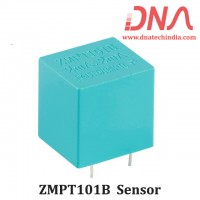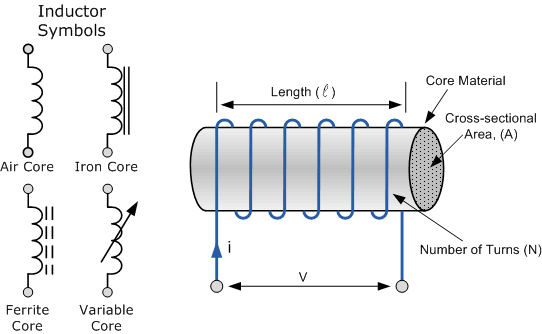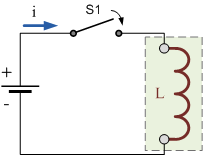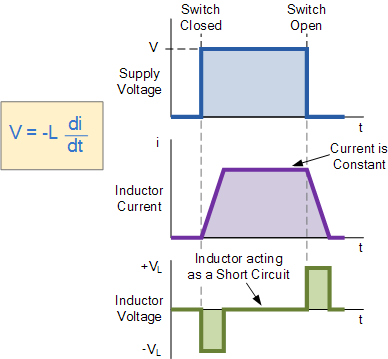The Inductor |
||||||||||||||||
|
In its most basic form, an Inductor is simply a coil of wire. For most coils the current, ( i ) flowing through the coil produces a magnetic flux, ( NΦ ) that is proportional to this flow of electrical current. In our tutorials about Electromagnetism we saw that when electrons flow through a conductor a magnetic flux is developed around the conductor producing a relationship between the direction of this flux around the conductor and the direction of the electrons flowing through the conductor, with this relationship being called, "Fleming's Left Hand Rule". But another important property of a wound coil exists, and that is a voltage is induced into the coil by this magnetic flux as it opposes or resists any changes in the electrical current flowing it. |
||||||||||||||||
|
The Inductor, also called a choke, is another passive type electrical component designed to take advantage of this relationship by producing a much stronger magnetic field than one that would be produced by a simple coil. Inductors are formed with wire tightly wrapped around a solid central core which can be either a straight cylindrical rod or a continuous loop or ring to concentrate their magnetic flux. The schematic symbol for a inductor is that of a coil of wire so therefore, a coil of wire can also be called an Inductor. Inductors are categorised according to the type of inner core with the different core types being distinguished by adding continuous or dotted parallel lines next to the wire coil as shown below. |
||||||||||||||||
|
|
||||||||||||||||
Inductor Symbols |
||||||||||||||||
|
|
||||||||||||||||
|
The current, i that flows through an inductor produces a magnetic flux that is proportional to it. But unlike a Capacitor which oppose a change of voltage across their plates, an inductor opposes the rate of change of current flowing through it due to the build up of self-induced energy within its magnetic field. In other words, inductors resist or oppose changes of current but will easily pass a steady state DC current. This ability of an inductor to resist changes in current and which also relates current, i with its magnetic flux linkage, NΦ as a constant of proportionality is called Inductance which is given the symbol L with units of Henry, (H) after Joseph Henry. |
||||||||||||||||
|
Because the Henry is a relatively large unit of inductance in its own right, for the smaller inductors sub-units of the Henry are used to denote its value. For example:
|
||||||||||||||||
|
||||||||||||||||
|
So to display the sub-units of the Henry we would use as an example: |
||||||||||||||||
|
1mH = 1 milli-Henry - which is equal to one thousandths (1/1000) of an Henry. 100uH = 100 micro-Henries - which is equal to 100 millionth's (1/1,000,000) of a Henry. |
||||||||||||||||
|
Inductors or coils are very common in electrical circuits and there are many factors which determine the inductance of a coil such as the shape of the coil, the number of turns of the insulated wire, the number of layers of wire, the spacing between the turns, the permeability of the core material, the size or cross-sectional area of the core etc, to name a few. An inductor coil has a central core area, (A) with a constant number of turns of wire per unit length, (l). So if a coil of N turns is linked by an amount of magnetic flux, Φ then the coil has a flux linkage of NΦ and any current, ( i ) that flows through the coil will produce an induced magnetic flux in the opposite direction to the flow of current. Then according to Faraday's Law, any change in this magnetic flux linkage produces a self-induced voltage in the single coil of: |
||||||||||||||||
|
|
||||||||||||||||
|
Where: N is the number of turns A is the cross-sectional Area in m2 Φ is the amount of flux in Webers μ is the Permeability of the core material l is the Length of the coil in meters di/dt is the Currents rate of change in amps/second |
||||||||||||||||
|
A time varying magnetic field induces a voltage that is proportional to the rate of change of the current producing it with a positive value indicating an increase in emf and a negative value indicating a decrease in emf. The equation relating this self-induced voltage, current and inductance can be found by substituting the μN2A / l with L denoting the constant of proportionality called the Inductance of the coil. |
||||||||||||||||
|
The relation between the flux in the inductor and the current flowing through the inductor is given as: Φ = Li. As an inductor consists of a coil of conducting wire, this then reduces the above equation to give the self-induced emf, sometimes called the back emf induced in the coil too: |
||||||||||||||||
|
|
||||||||||||||||
The back emf Generated by an Inductor |
||||||||||||||||
|
|
||||||||||||||||
|
Where: L is the self-inductance and di/dt the rate of current change. |
||||||||||||||||
|
So from this equation we can say that the "self-induced emf = inductance x rate of current change" and a circuit has an inductance of one Henry will have an emf of one volt induced in the circuit when the current flowing through the circuit changes at a rate of one ampere per second. |
||||||||||||||||
One important point to note about the above equation. It only relates the emf produced across the inductor to changes in current because if the flow of inductor current is constant and not changing such as in a steady state DC current, then the induced emf voltage will be zero because the instantaneous rate of current change is zero, di/dt = 0. With a steady state DC current flowing through the inductor and therefore zero induced voltage across it, the inductor acts as a short circuit equal to a piece of wire, in the presence of a continuous current. In other words, the opposition to the flow ofcurrent offered by an inductor is different between AC and DC circuits. |
||||||||||||||||
|
|
||||||||||||||||
The Time Constant of an Inductor |
||||||||||||||||
|
We now know that the current can not change instantaneously in an inductor because for this to occur, the current would need to change by a finite amount in zero time which would result in the rate of current change being infinite, di/dt = ∞, making the induced emf infinite as well and infinite voltages do no exist. However, if the current flowing through an inductor changes very rapidly, such as with the operation of a switch, high voltages can be induced across the inductors coil. |
||||||||||||||||
Consider the circuit of the inductor on the right. With the switch, (S1) open no current flows through the inductor coil, so the rate of change of current change (di/dt) in its coil is zero and therefore, zero self-induced emf exists across the inductor, (VL = 0). If we now close the switch (t = 0), a current will flow through the circuit and slowly rise to its maximum value at a rate determined by the inductance of the inductor. This rate of current flowing through the inductor multiplied by the inductors inductance in Henry's, results in some fixed value self-induced emf being produced across the coil as determined by Faraday's equation above, VL = Ldi/dt. |
||||||||||||||||
|
This self-induced emf across the inductors coil, (VL) fights against the applied voltage until the current reaches its maximum value and a steady state condition is reached. The current which now flows through the coil is determined only by the DC or "pure" resistance of the coils windings as the reactance value of the coil has decreased to zero because the rate of change of current (di/dt) is zero in steady state. In other words, only the coils DC resistance now exists to oppose the flow of current. |
||||||||||||||||
|
Likewise, if switch, (S1) is opened, the current flowing through the coil will start to fall but the inductor will again fight against this change and try to keep the current flowing at its previous value by inducing a voltage in the other direction. The slope of the fall will be negative and related to the inductance of the coil as shown below. |
||||||||||||||||
|
|
||||||||||||||||
Current and Voltage in an Inductor |
||||||||||||||||
|
|
||||||||||||||||
|
How much induced voltage will be produced by the inductor depends upon the rate of current change. In our tutorial about Electromagnetic Induction, Lenz's Law stated that: "the direction of an induced emf is such that it will always opposes the change that is causing it". In other words, an induced emf will always OPPOSE the motion or change which started the induced emf in the first place. So with a decreasing current the voltage polarity will be acting as a source and with an increasing current the voltage polarity will be acting as a load. So for the same rate of current change through the coil, either increasing or decreasing the magnitude of the induced emf will be the same. |
||||||||||||||||
|
|
||||||||||||||||
Example No1 |
||||||||||||||||
|
A steady state direct current of 4 ampere passes through a solenoid coil of 0.5H. What would be the voltage induced in the coil if the switch opened for 10mS and the current flowing through the coil dropped to zero ampere. |
||||||||||||||||
|
|
||||||||||||||||
Power and Energy in an Inductor |
||||||||||||||||
Power in an Inductor |
||||||||||||||||
|
We know that an inductor in a circuit opposes the flow of current, ( i ) through it because the flow of this current induces an emf that opposes it, Lenz's Law. Then work has to be done by the external battery source in order to keep the current flowing against this induced emf. The instantaneous power used in forcing the current, ( i ) against this self-induced emf, ( VL ) is given from above as: |
||||||||||||||||
 |
||||||||||||||||
|
Power in a circuit is given as, P = V.I therefore: |
||||||||||||||||
|
|
||||||||||||||||
|
An ideal inductor has no resistance only inductance so R = 0 Ω's and therefore no power is dissipated within the coil, so we can say that an ideal inductor has zero power loss. |
||||||||||||||||
|
|
||||||||||||||||
Energy in an Inductor |
||||||||||||||||
|
When power flows into an inductor, energy is stored in its magnetic field. When the current flowing through the inductor is increasing and di/dt becomes greater than zero, the instantaneous power in the circuit must also be greater than zero, ( P > 0 ) ie, positive which means that energy is being stored in the inductor. Likewise, if the current through the inductor is decreasing and di/dt is less than zero then the instantaneous power must also be less than zero, ( P < 0 ) ie negative which means that the inductor is returning energy back into the circuit. Then by integrating the equation for power above, the total magnetic energy which is always positive, being stored in the inductor is therefore given as: |
||||||||||||||||
|
|
||||||||||||||||
Energy stored by an Inductor |
||||||||||||||||
|
|
||||||||||||||||
|
Where: W is in joules, L is in Henries and i is in Amperes |
||||||||||||||||
|
The energy is actually being stored within the magnetic field that surrounds the inductor by the current flowing through it. In an ideal inductor that has no resistance or capacitance, as the current increases energy flows into the inductor and is stored there within its magnetic field without loss, it is not released until the current decreases and the magnetic field collapses. Then in an alternating current, AC circuit an inductor is constantly storing and delivering energy on each and every cycle. If the current flowing through the inductor is constant as in a DC circuit, then there is no change in the stored energy as P = Li(di/dt) = 0. |
||||||||||||||||
|
So inductors can be defined as passive components as they can both stored and deliver energy to the circuit, but they cannot generate energy. An ideal inductor is classed as loss less, meaning that it can store energy indefinitely as no energy is lost. However, real inductors will always have some resistance associated with the windings of the coil and whenever current flows through a resistance energy is lost in the form of heat due to Ohms Law, ( P = I2 R ) regardless of whether the current is alternating or constant. |
||||||||||||||||
|
In the next tutorial about Inductors, we will see that the effective resistance of a coil is called Inductance, and that inductance which as we now know is the characteristic of an electrical conductor that "opposes a change in the current", can either be internally induced, called self-inductance or externally induced, called mutual-inductance. |
||||||||||||||||
|
|
||||||||||||||||
| Reproduced with permission from Wayne Storr | ||||||||||||||||
| ( http://www.electronics-tutorials.ws/inductor/inductor.html ) |











